Analysis of Contracts, Negligence, and Liability in Business Law
VerifiedAdded on 2020/02/12
|18
|5847
|81
Homework Assignment
AI Summary
This assignment delves into the core principles of contract and negligence law within a UK business context. It begins by examining the essential elements of contract formation, including offer, acceptance, consideration, and the intention to create legal relations. The assignment then explores different types of contracts, such as bilateral and unilateral contracts, and analyzes the various terms that can be included in a valid contract, including express, implied, conditions, warranties, and exclusion clauses. A key component involves the creation of a sample contract for the purchase of a product, alongside an application of the terms within the contract and a detailed report on condition and exemption clauses. The assignment further distinguishes between contract and tort liability, elucidating the principles of negligence and its implications in business activities, including vicarious liability. Through case examples and legal frameworks, the assignment provides a comprehensive understanding of legal obligations and liabilities faced by businesses.
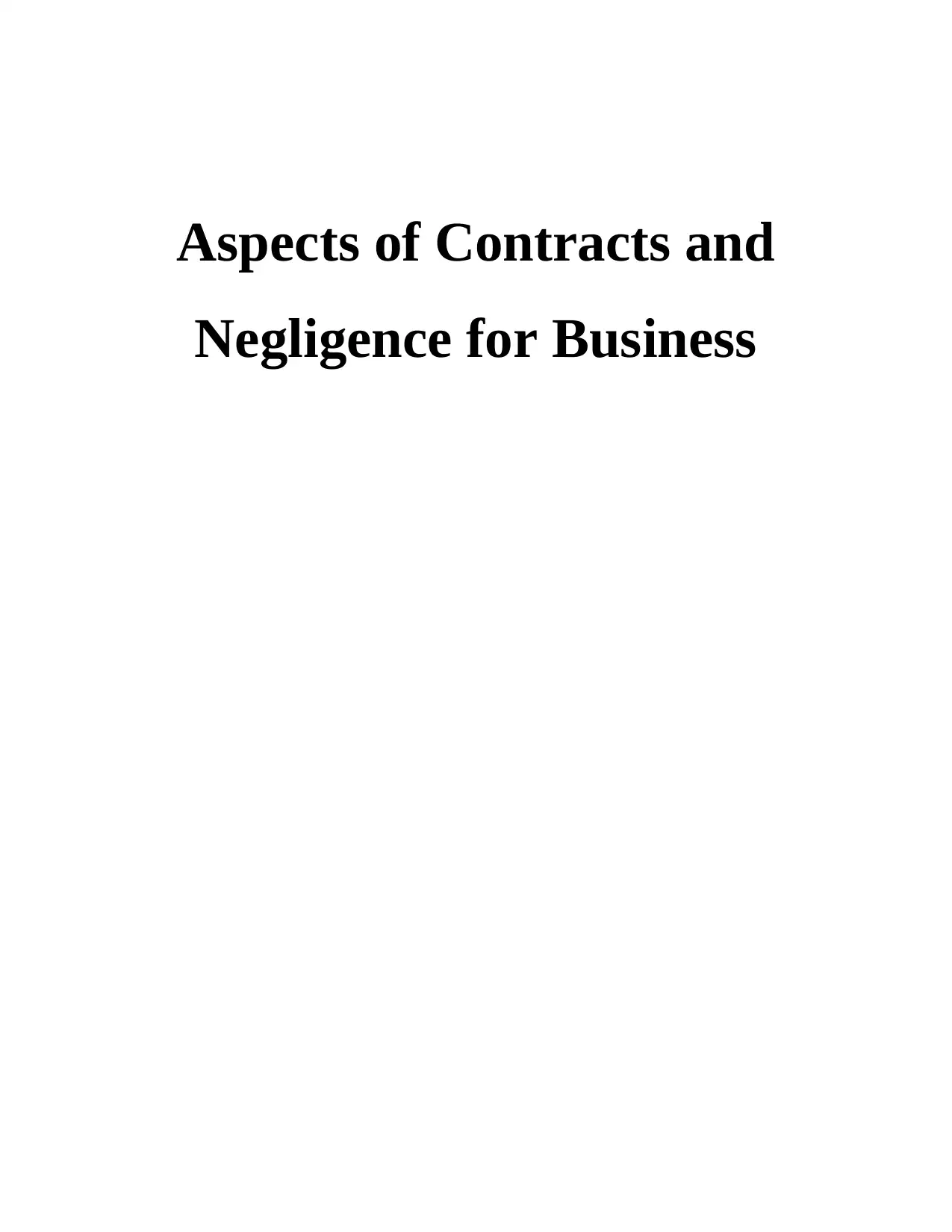
Aspects of Contracts and
Negligence for Business
Negligence for Business
Paraphrase This Document
Need a fresh take? Get an instant paraphrase of this document with our AI Paraphraser
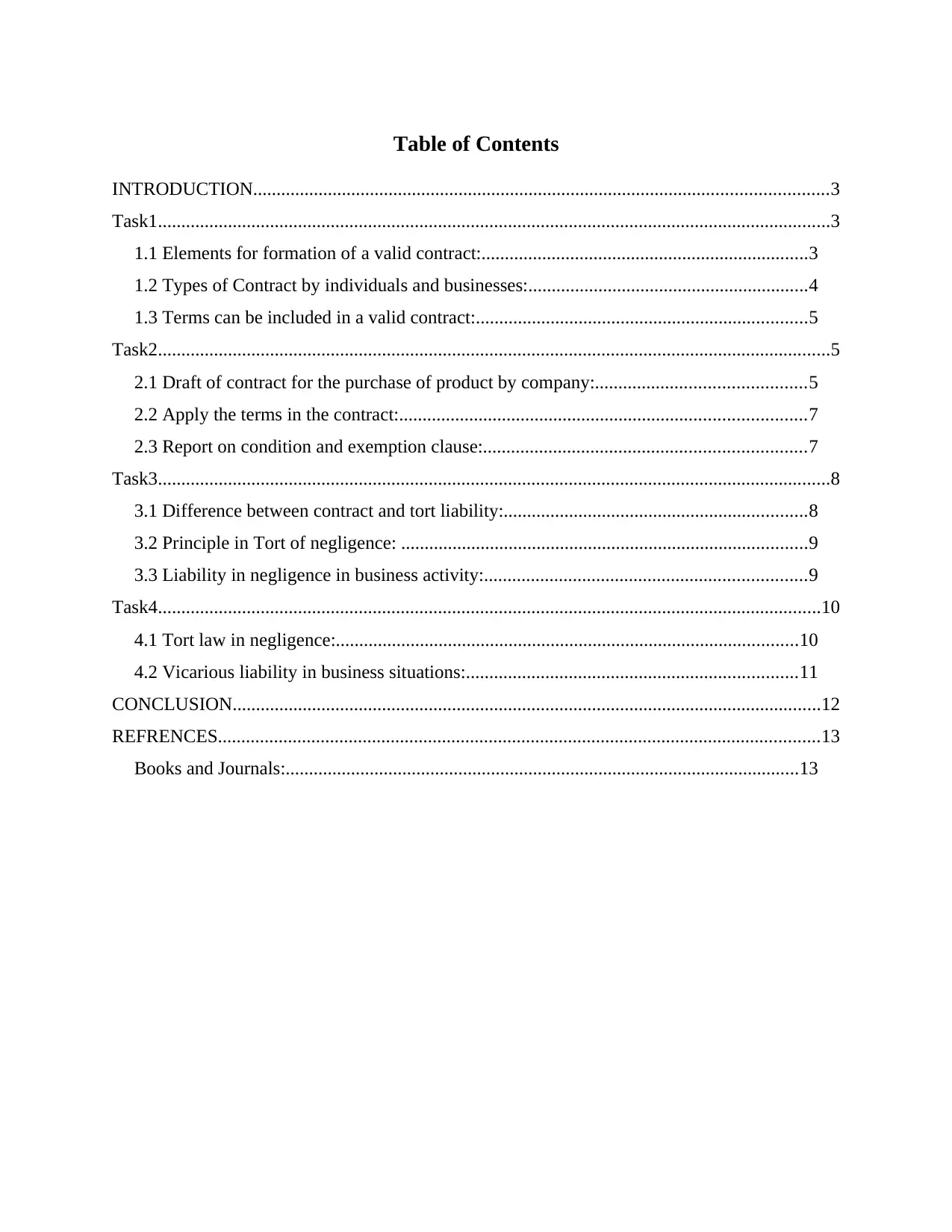
Table of Contents
INTRODUCTION...........................................................................................................................3
Task1................................................................................................................................................3
1.1 Elements for formation of a valid contract:......................................................................3
1.2 Types of Contract by individuals and businesses:............................................................4
1.3 Terms can be included in a valid contract:.......................................................................5
Task2................................................................................................................................................5
2.1 Draft of contract for the purchase of product by company:.............................................5
2.2 Apply the terms in the contract:.......................................................................................7
2.3 Report on condition and exemption clause:.....................................................................7
Task3................................................................................................................................................8
3.1 Difference between contract and tort liability:.................................................................8
3.2 Principle in Tort of negligence: .......................................................................................9
3.3 Liability in negligence in business activity:.....................................................................9
Task4..............................................................................................................................................10
4.1 Tort law in negligence:...................................................................................................10
4.2 Vicarious liability in business situations:.......................................................................11
CONCLUSION..............................................................................................................................12
REFRENCES.................................................................................................................................13
Books and Journals:..............................................................................................................13
INTRODUCTION...........................................................................................................................3
Task1................................................................................................................................................3
1.1 Elements for formation of a valid contract:......................................................................3
1.2 Types of Contract by individuals and businesses:............................................................4
1.3 Terms can be included in a valid contract:.......................................................................5
Task2................................................................................................................................................5
2.1 Draft of contract for the purchase of product by company:.............................................5
2.2 Apply the terms in the contract:.......................................................................................7
2.3 Report on condition and exemption clause:.....................................................................7
Task3................................................................................................................................................8
3.1 Difference between contract and tort liability:.................................................................8
3.2 Principle in Tort of negligence: .......................................................................................9
3.3 Liability in negligence in business activity:.....................................................................9
Task4..............................................................................................................................................10
4.1 Tort law in negligence:...................................................................................................10
4.2 Vicarious liability in business situations:.......................................................................11
CONCLUSION..............................................................................................................................12
REFRENCES.................................................................................................................................13
Books and Journals:..............................................................................................................13
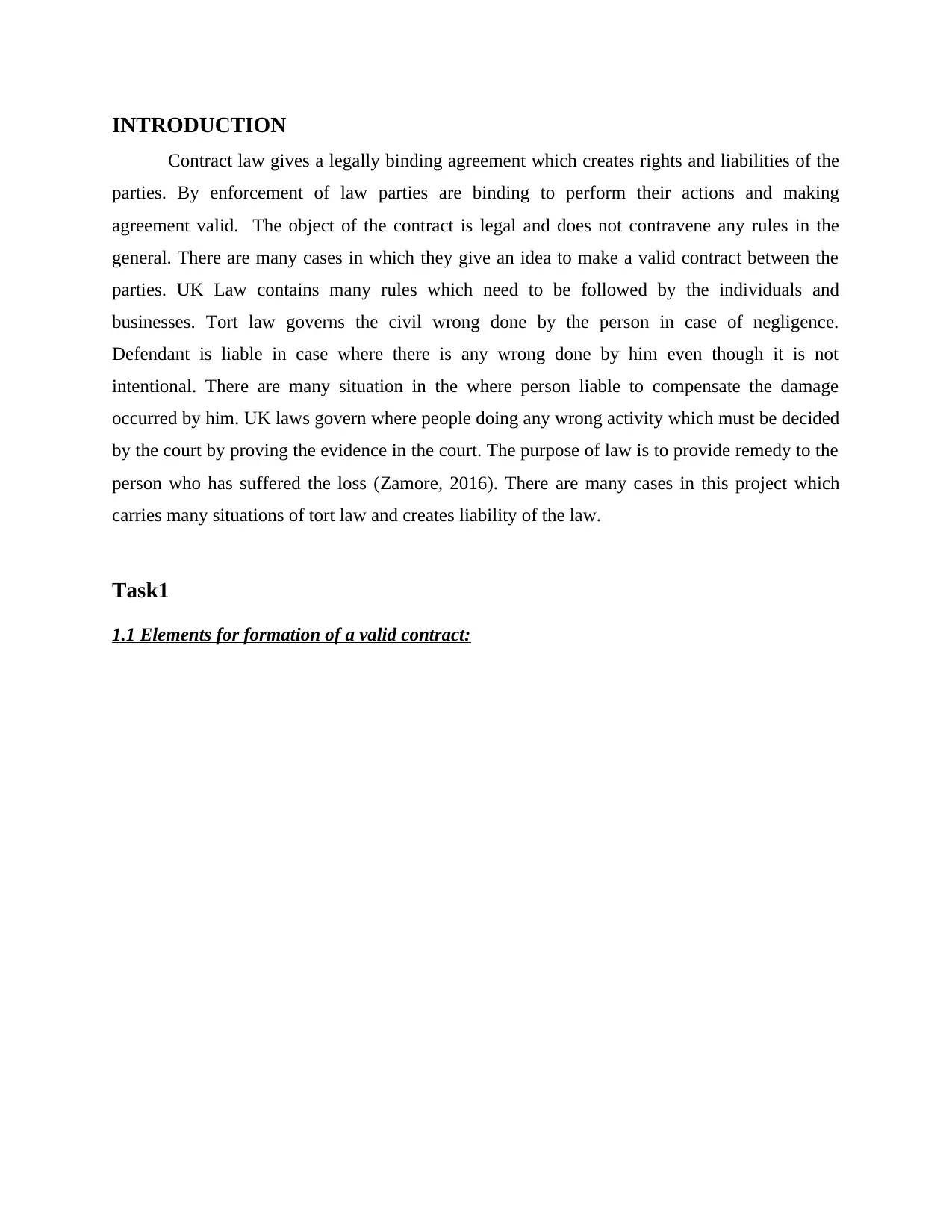
INTRODUCTION
Contract law gives a legally binding agreement which creates rights and liabilities of the
parties. By enforcement of law parties are binding to perform their actions and making
agreement valid. The object of the contract is legal and does not contravene any rules in the
general. There are many cases in which they give an idea to make a valid contract between the
parties. UK Law contains many rules which need to be followed by the individuals and
businesses. Tort law governs the civil wrong done by the person in case of negligence.
Defendant is liable in case where there is any wrong done by him even though it is not
intentional. There are many situation in the where person liable to compensate the damage
occurred by him. UK laws govern where people doing any wrong activity which must be decided
by the court by proving the evidence in the court. The purpose of law is to provide remedy to the
person who has suffered the loss (Zamore, 2016). There are many cases in this project which
carries many situations of tort law and creates liability of the law.
Task1
1.1 Elements for formation of a valid contract:
Contract law gives a legally binding agreement which creates rights and liabilities of the
parties. By enforcement of law parties are binding to perform their actions and making
agreement valid. The object of the contract is legal and does not contravene any rules in the
general. There are many cases in which they give an idea to make a valid contract between the
parties. UK Law contains many rules which need to be followed by the individuals and
businesses. Tort law governs the civil wrong done by the person in case of negligence.
Defendant is liable in case where there is any wrong done by him even though it is not
intentional. There are many situation in the where person liable to compensate the damage
occurred by him. UK laws govern where people doing any wrong activity which must be decided
by the court by proving the evidence in the court. The purpose of law is to provide remedy to the
person who has suffered the loss (Zamore, 2016). There are many cases in this project which
carries many situations of tort law and creates liability of the law.
Task1
1.1 Elements for formation of a valid contract:
⊘ This is a preview!⊘
Do you want full access?
Subscribe today to unlock all pages.

Trusted by 1+ million students worldwide
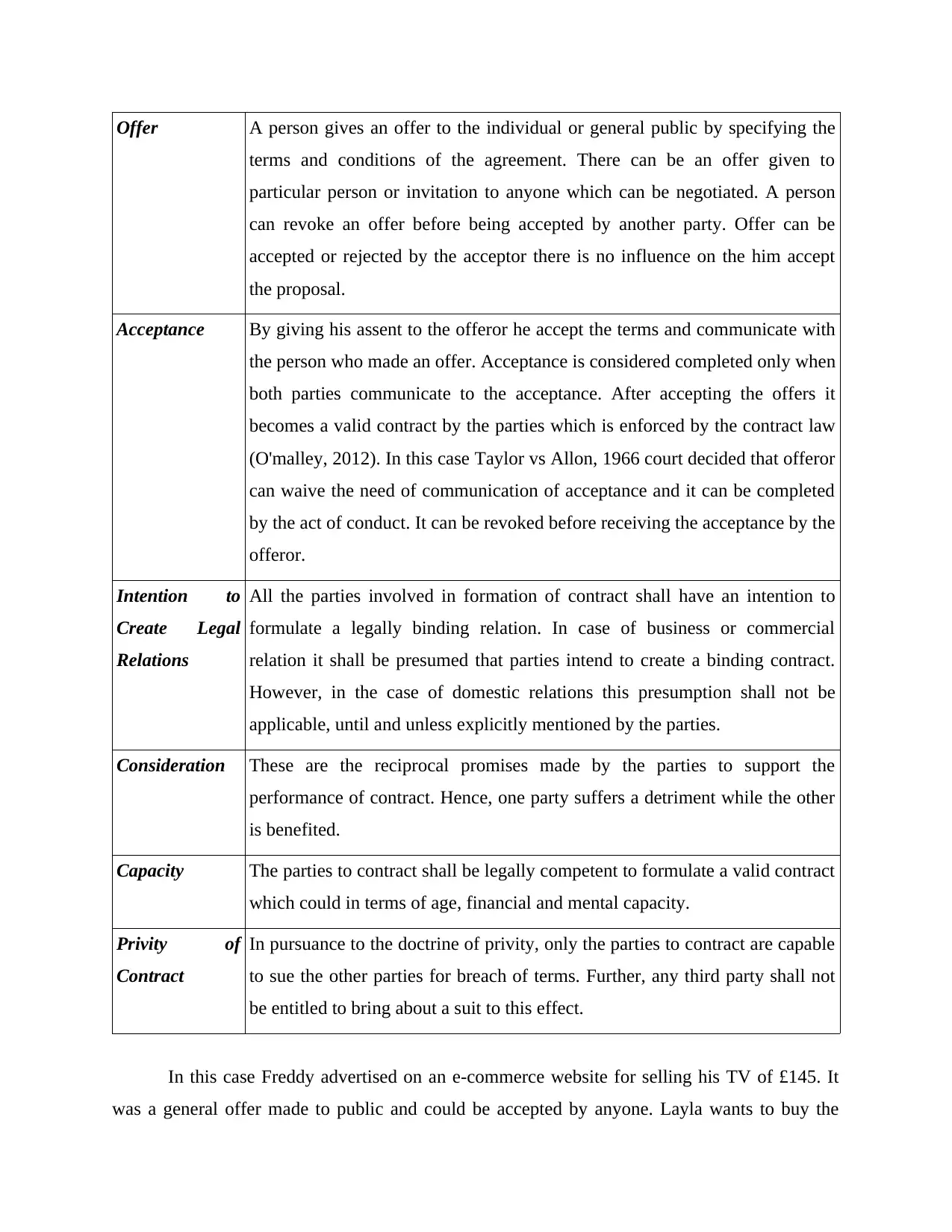
Offer A person gives an offer to the individual or general public by specifying the
terms and conditions of the agreement. There can be an offer given to
particular person or invitation to anyone which can be negotiated. A person
can revoke an offer before being accepted by another party. Offer can be
accepted or rejected by the acceptor there is no influence on the him accept
the proposal.
Acceptance By giving his assent to the offeror he accept the terms and communicate with
the person who made an offer. Acceptance is considered completed only when
both parties communicate to the acceptance. After accepting the offers it
becomes a valid contract by the parties which is enforced by the contract law
(O'malley, 2012). In this case Taylor vs Allon, 1966 court decided that offeror
can waive the need of communication of acceptance and it can be completed
by the act of conduct. It can be revoked before receiving the acceptance by the
offeror.
Intention to
Create Legal
Relations
All the parties involved in formation of contract shall have an intention to
formulate a legally binding relation. In case of business or commercial
relation it shall be presumed that parties intend to create a binding contract.
However, in the case of domestic relations this presumption shall not be
applicable, until and unless explicitly mentioned by the parties.
Consideration These are the reciprocal promises made by the parties to support the
performance of contract. Hence, one party suffers a detriment while the other
is benefited.
Capacity The parties to contract shall be legally competent to formulate a valid contract
which could in terms of age, financial and mental capacity.
Privity of
Contract
In pursuance to the doctrine of privity, only the parties to contract are capable
to sue the other parties for breach of terms. Further, any third party shall not
be entitled to bring about a suit to this effect.
In this case Freddy advertised on an e-commerce website for selling his TV of £145. It
was a general offer made to public and could be accepted by anyone. Layla wants to buy the
terms and conditions of the agreement. There can be an offer given to
particular person or invitation to anyone which can be negotiated. A person
can revoke an offer before being accepted by another party. Offer can be
accepted or rejected by the acceptor there is no influence on the him accept
the proposal.
Acceptance By giving his assent to the offeror he accept the terms and communicate with
the person who made an offer. Acceptance is considered completed only when
both parties communicate to the acceptance. After accepting the offers it
becomes a valid contract by the parties which is enforced by the contract law
(O'malley, 2012). In this case Taylor vs Allon, 1966 court decided that offeror
can waive the need of communication of acceptance and it can be completed
by the act of conduct. It can be revoked before receiving the acceptance by the
offeror.
Intention to
Create Legal
Relations
All the parties involved in formation of contract shall have an intention to
formulate a legally binding relation. In case of business or commercial
relation it shall be presumed that parties intend to create a binding contract.
However, in the case of domestic relations this presumption shall not be
applicable, until and unless explicitly mentioned by the parties.
Consideration These are the reciprocal promises made by the parties to support the
performance of contract. Hence, one party suffers a detriment while the other
is benefited.
Capacity The parties to contract shall be legally competent to formulate a valid contract
which could in terms of age, financial and mental capacity.
Privity of
Contract
In pursuance to the doctrine of privity, only the parties to contract are capable
to sue the other parties for breach of terms. Further, any third party shall not
be entitled to bring about a suit to this effect.
In this case Freddy advertised on an e-commerce website for selling his TV of £145. It
was a general offer made to public and could be accepted by anyone. Layla wants to buy the
Paraphrase This Document
Need a fresh take? Get an instant paraphrase of this document with our AI Paraphraser
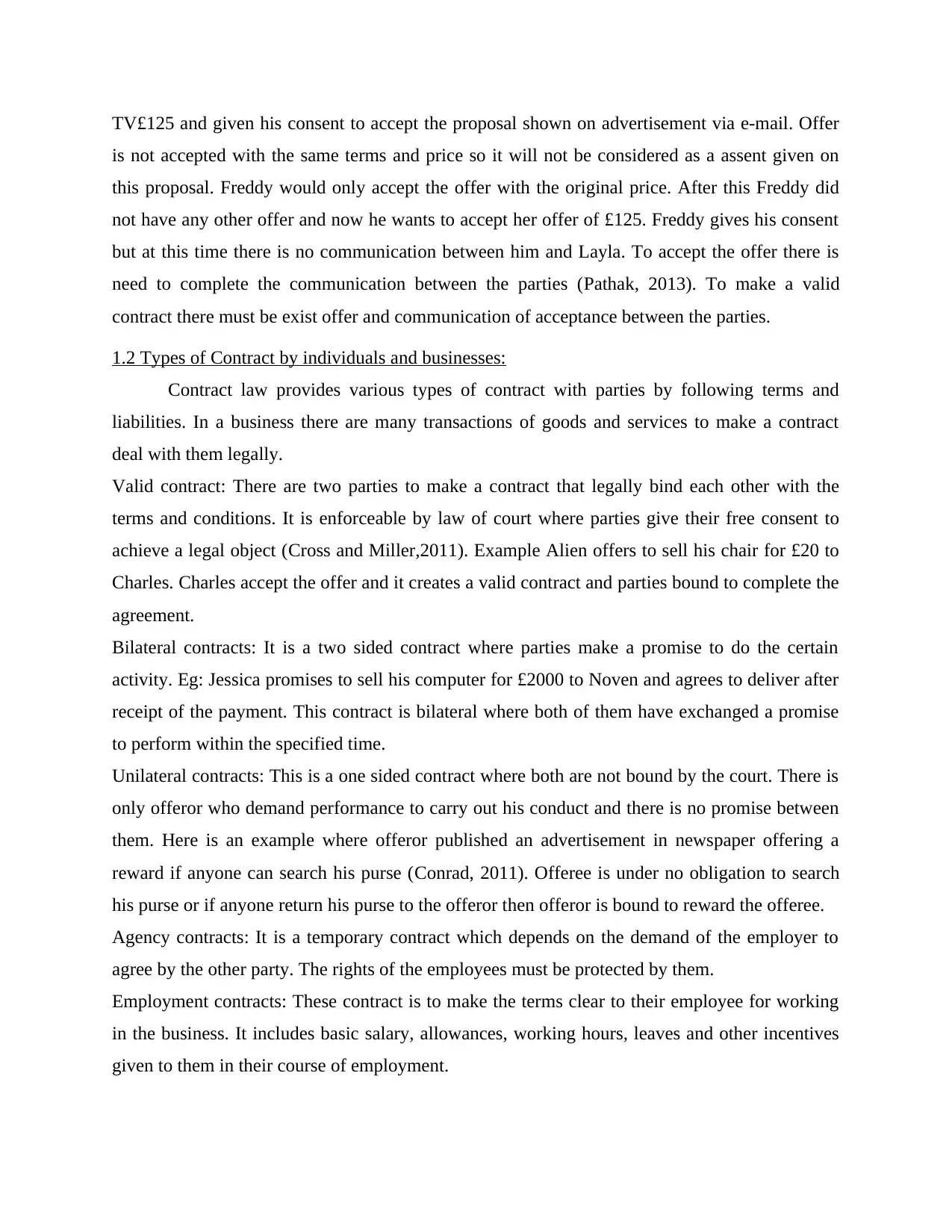
TV£125 and given his consent to accept the proposal shown on advertisement via e-mail. Offer
is not accepted with the same terms and price so it will not be considered as a assent given on
this proposal. Freddy would only accept the offer with the original price. After this Freddy did
not have any other offer and now he wants to accept her offer of £125. Freddy gives his consent
but at this time there is no communication between him and Layla. To accept the offer there is
need to complete the communication between the parties (Pathak, 2013). To make a valid
contract there must be exist offer and communication of acceptance between the parties.
1.2 Types of Contract by individuals and businesses:
Contract law provides various types of contract with parties by following terms and
liabilities. In a business there are many transactions of goods and services to make a contract
deal with them legally.
Valid contract: There are two parties to make a contract that legally bind each other with the
terms and conditions. It is enforceable by law of court where parties give their free consent to
achieve a legal object (Cross and Miller,2011). Example Alien offers to sell his chair for £20 to
Charles. Charles accept the offer and it creates a valid contract and parties bound to complete the
agreement.
Bilateral contracts: It is a two sided contract where parties make a promise to do the certain
activity. Eg: Jessica promises to sell his computer for £2000 to Noven and agrees to deliver after
receipt of the payment. This contract is bilateral where both of them have exchanged a promise
to perform within the specified time.
Unilateral contracts: This is a one sided contract where both are not bound by the court. There is
only offeror who demand performance to carry out his conduct and there is no promise between
them. Here is an example where offeror published an advertisement in newspaper offering a
reward if anyone can search his purse (Conrad, 2011). Offeree is under no obligation to search
his purse or if anyone return his purse to the offeror then offeror is bound to reward the offeree.
Agency contracts: It is a temporary contract which depends on the demand of the employer to
agree by the other party. The rights of the employees must be protected by them.
Employment contracts: These contract is to make the terms clear to their employee for working
in the business. It includes basic salary, allowances, working hours, leaves and other incentives
given to them in their course of employment.
is not accepted with the same terms and price so it will not be considered as a assent given on
this proposal. Freddy would only accept the offer with the original price. After this Freddy did
not have any other offer and now he wants to accept her offer of £125. Freddy gives his consent
but at this time there is no communication between him and Layla. To accept the offer there is
need to complete the communication between the parties (Pathak, 2013). To make a valid
contract there must be exist offer and communication of acceptance between the parties.
1.2 Types of Contract by individuals and businesses:
Contract law provides various types of contract with parties by following terms and
liabilities. In a business there are many transactions of goods and services to make a contract
deal with them legally.
Valid contract: There are two parties to make a contract that legally bind each other with the
terms and conditions. It is enforceable by law of court where parties give their free consent to
achieve a legal object (Cross and Miller,2011). Example Alien offers to sell his chair for £20 to
Charles. Charles accept the offer and it creates a valid contract and parties bound to complete the
agreement.
Bilateral contracts: It is a two sided contract where parties make a promise to do the certain
activity. Eg: Jessica promises to sell his computer for £2000 to Noven and agrees to deliver after
receipt of the payment. This contract is bilateral where both of them have exchanged a promise
to perform within the specified time.
Unilateral contracts: This is a one sided contract where both are not bound by the court. There is
only offeror who demand performance to carry out his conduct and there is no promise between
them. Here is an example where offeror published an advertisement in newspaper offering a
reward if anyone can search his purse (Conrad, 2011). Offeree is under no obligation to search
his purse or if anyone return his purse to the offeror then offeror is bound to reward the offeree.
Agency contracts: It is a temporary contract which depends on the demand of the employer to
agree by the other party. The rights of the employees must be protected by them.
Employment contracts: These contract is to make the terms clear to their employee for working
in the business. It includes basic salary, allowances, working hours, leaves and other incentives
given to them in their course of employment.
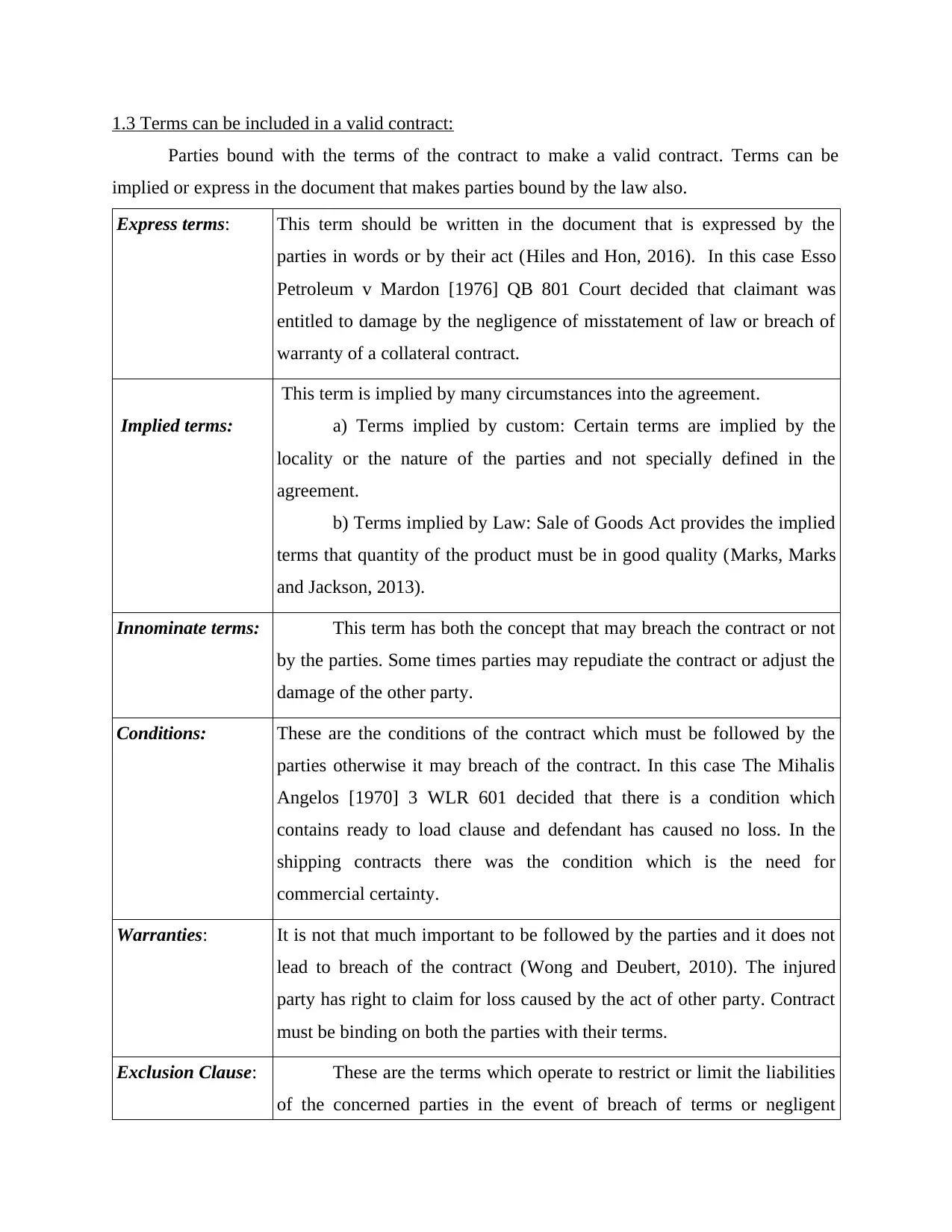
1.3 Terms can be included in a valid contract:
Parties bound with the terms of the contract to make a valid contract. Terms can be
implied or express in the document that makes parties bound by the law also.
Express terms: This term should be written in the document that is expressed by the
parties in words or by their act (Hiles and Hon, 2016). In this case Esso
Petroleum v Mardon [1976] QB 801 Court decided that claimant was
entitled to damage by the negligence of misstatement of law or breach of
warranty of a collateral contract.
Implied terms:
This term is implied by many circumstances into the agreement.
a) Terms implied by custom: Certain terms are implied by the
locality or the nature of the parties and not specially defined in the
agreement.
b) Terms implied by Law: Sale of Goods Act provides the implied
terms that quantity of the product must be in good quality (Marks, Marks
and Jackson, 2013).
Innominate terms: This term has both the concept that may breach the contract or not
by the parties. Some times parties may repudiate the contract or adjust the
damage of the other party.
Conditions: These are the conditions of the contract which must be followed by the
parties otherwise it may breach of the contract. In this case The Mihalis
Angelos [1970] 3 WLR 601 decided that there is a condition which
contains ready to load clause and defendant has caused no loss. In the
shipping contracts there was the condition which is the need for
commercial certainty.
Warranties: It is not that much important to be followed by the parties and it does not
lead to breach of the contract (Wong and Deubert, 2010). The injured
party has right to claim for loss caused by the act of other party. Contract
must be binding on both the parties with their terms.
Exclusion Clause: These are the terms which operate to restrict or limit the liabilities
of the concerned parties in the event of breach of terms or negligent
Parties bound with the terms of the contract to make a valid contract. Terms can be
implied or express in the document that makes parties bound by the law also.
Express terms: This term should be written in the document that is expressed by the
parties in words or by their act (Hiles and Hon, 2016). In this case Esso
Petroleum v Mardon [1976] QB 801 Court decided that claimant was
entitled to damage by the negligence of misstatement of law or breach of
warranty of a collateral contract.
Implied terms:
This term is implied by many circumstances into the agreement.
a) Terms implied by custom: Certain terms are implied by the
locality or the nature of the parties and not specially defined in the
agreement.
b) Terms implied by Law: Sale of Goods Act provides the implied
terms that quantity of the product must be in good quality (Marks, Marks
and Jackson, 2013).
Innominate terms: This term has both the concept that may breach the contract or not
by the parties. Some times parties may repudiate the contract or adjust the
damage of the other party.
Conditions: These are the conditions of the contract which must be followed by the
parties otherwise it may breach of the contract. In this case The Mihalis
Angelos [1970] 3 WLR 601 decided that there is a condition which
contains ready to load clause and defendant has caused no loss. In the
shipping contracts there was the condition which is the need for
commercial certainty.
Warranties: It is not that much important to be followed by the parties and it does not
lead to breach of the contract (Wong and Deubert, 2010). The injured
party has right to claim for loss caused by the act of other party. Contract
must be binding on both the parties with their terms.
Exclusion Clause: These are the terms which operate to restrict or limit the liabilities
of the concerned parties in the event of breach of terms or negligent
⊘ This is a preview!⊘
Do you want full access?
Subscribe today to unlock all pages.

Trusted by 1+ million students worldwide
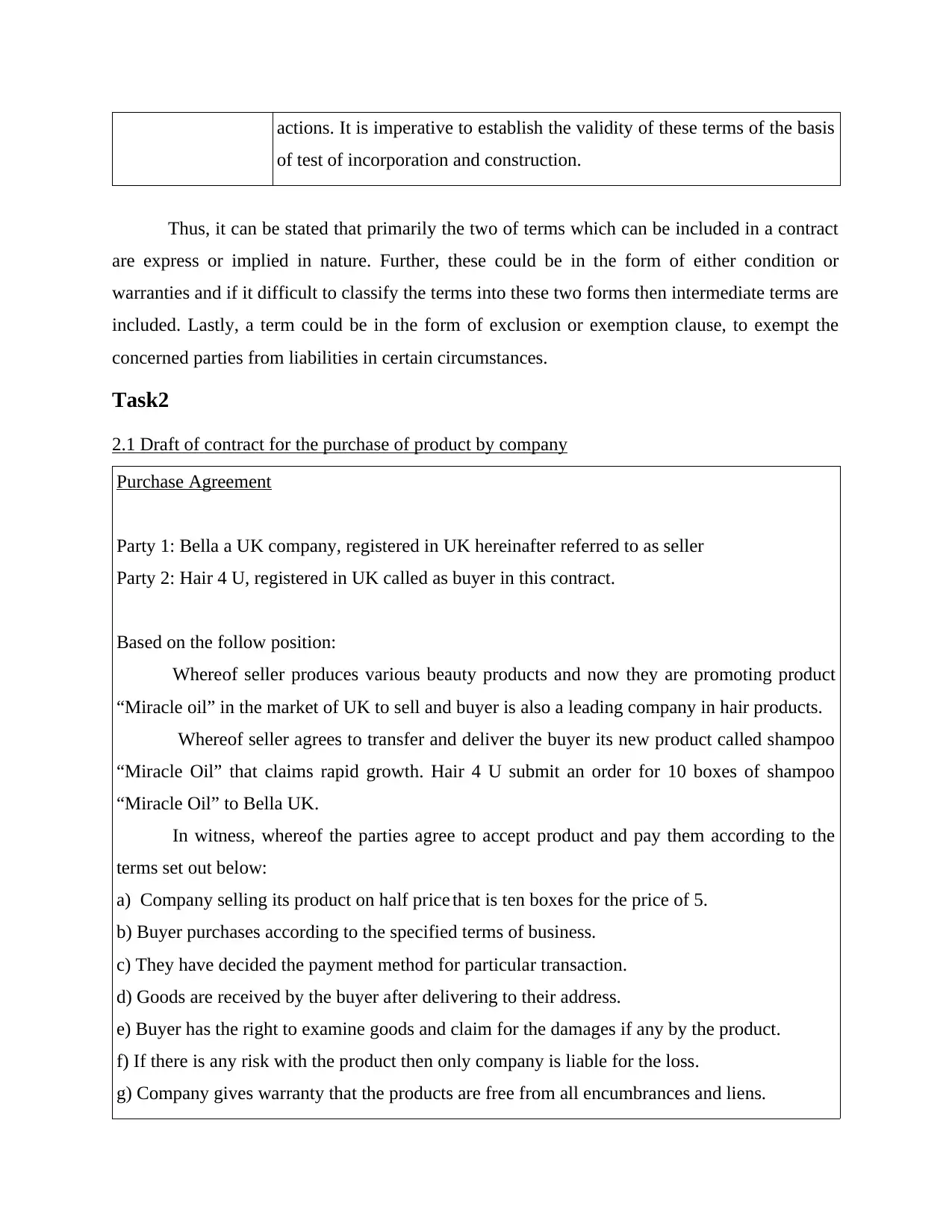
actions. It is imperative to establish the validity of these terms of the basis
of test of incorporation and construction.
Thus, it can be stated that primarily the two of terms which can be included in a contract
are express or implied in nature. Further, these could be in the form of either condition or
warranties and if it difficult to classify the terms into these two forms then intermediate terms are
included. Lastly, a term could be in the form of exclusion or exemption clause, to exempt the
concerned parties from liabilities in certain circumstances.
Task2
2.1 Draft of contract for the purchase of product by company
Purchase Agreement
Party 1: Bella a UK company, registered in UK hereinafter referred to as seller
Party 2: Hair 4 U, registered in UK called as buyer in this contract.
Based on the follow position:
Whereof seller produces various beauty products and now they are promoting product
“Miracle oil” in the market of UK to sell and buyer is also a leading company in hair products.
Whereof seller agrees to transfer and deliver the buyer its new product called shampoo
“Miracle Oil” that claims rapid growth. Hair 4 U submit an order for 10 boxes of shampoo
“Miracle Oil” to Bella UK.
In witness, whereof the parties agree to accept product and pay them according to the
terms set out below:
a) Company selling its product on half price that is ten boxes for the price of 5.
b) Buyer purchases according to the specified terms of business.
c) They have decided the payment method for particular transaction.
d) Goods are received by the buyer after delivering to their address.
e) Buyer has the right to examine goods and claim for the damages if any by the product.
f) If there is any risk with the product then only company is liable for the loss.
g) Company gives warranty that the products are free from all encumbrances and liens.
of test of incorporation and construction.
Thus, it can be stated that primarily the two of terms which can be included in a contract
are express or implied in nature. Further, these could be in the form of either condition or
warranties and if it difficult to classify the terms into these two forms then intermediate terms are
included. Lastly, a term could be in the form of exclusion or exemption clause, to exempt the
concerned parties from liabilities in certain circumstances.
Task2
2.1 Draft of contract for the purchase of product by company
Purchase Agreement
Party 1: Bella a UK company, registered in UK hereinafter referred to as seller
Party 2: Hair 4 U, registered in UK called as buyer in this contract.
Based on the follow position:
Whereof seller produces various beauty products and now they are promoting product
“Miracle oil” in the market of UK to sell and buyer is also a leading company in hair products.
Whereof seller agrees to transfer and deliver the buyer its new product called shampoo
“Miracle Oil” that claims rapid growth. Hair 4 U submit an order for 10 boxes of shampoo
“Miracle Oil” to Bella UK.
In witness, whereof the parties agree to accept product and pay them according to the
terms set out below:
a) Company selling its product on half price that is ten boxes for the price of 5.
b) Buyer purchases according to the specified terms of business.
c) They have decided the payment method for particular transaction.
d) Goods are received by the buyer after delivering to their address.
e) Buyer has the right to examine goods and claim for the damages if any by the product.
f) If there is any risk with the product then only company is liable for the loss.
g) Company gives warranty that the products are free from all encumbrances and liens.
Paraphrase This Document
Need a fresh take? Get an instant paraphrase of this document with our AI Paraphraser
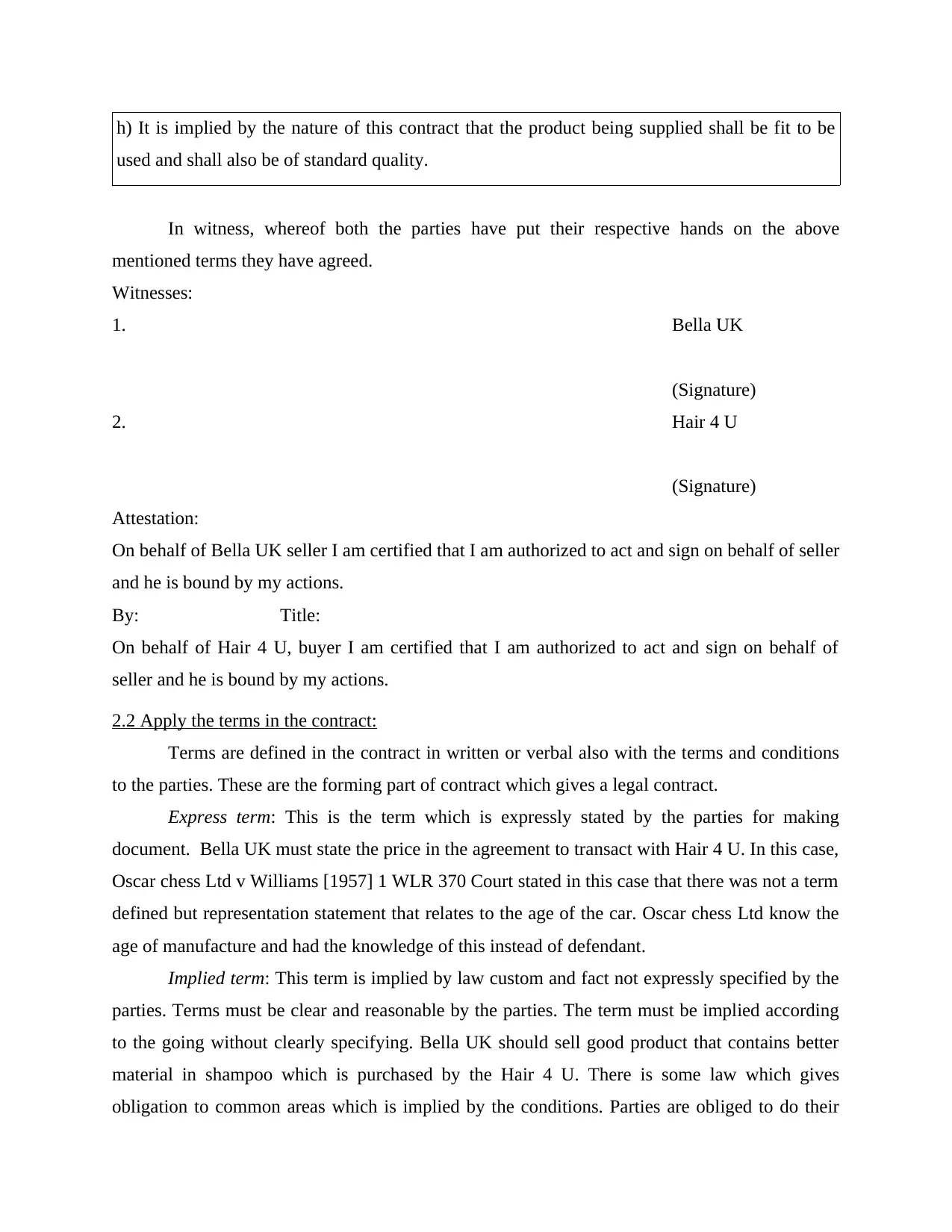
h) It is implied by the nature of this contract that the product being supplied shall be fit to be
used and shall also be of standard quality.
In witness, whereof both the parties have put their respective hands on the above
mentioned terms they have agreed.
Witnesses:
1. Bella UK
(Signature)
2. Hair 4 U
(Signature)
Attestation:
On behalf of Bella UK seller I am certified that I am authorized to act and sign on behalf of seller
and he is bound by my actions.
By: Title:
On behalf of Hair 4 U, buyer I am certified that I am authorized to act and sign on behalf of
seller and he is bound by my actions.
2.2 Apply the terms in the contract:
Terms are defined in the contract in written or verbal also with the terms and conditions
to the parties. These are the forming part of contract which gives a legal contract.
Express term: This is the term which is expressly stated by the parties for making
document. Bella UK must state the price in the agreement to transact with Hair 4 U. In this case,
Oscar chess Ltd v Williams [1957] 1 WLR 370 Court stated in this case that there was not a term
defined but representation statement that relates to the age of the car. Oscar chess Ltd know the
age of manufacture and had the knowledge of this instead of defendant.
Implied term: This term is implied by law custom and fact not expressly specified by the
parties. Terms must be clear and reasonable by the parties. The term must be implied according
to the going without clearly specifying. Bella UK should sell good product that contains better
material in shampoo which is purchased by the Hair 4 U. There is some law which gives
obligation to common areas which is implied by the conditions. Parties are obliged to do their
used and shall also be of standard quality.
In witness, whereof both the parties have put their respective hands on the above
mentioned terms they have agreed.
Witnesses:
1. Bella UK
(Signature)
2. Hair 4 U
(Signature)
Attestation:
On behalf of Bella UK seller I am certified that I am authorized to act and sign on behalf of seller
and he is bound by my actions.
By: Title:
On behalf of Hair 4 U, buyer I am certified that I am authorized to act and sign on behalf of
seller and he is bound by my actions.
2.2 Apply the terms in the contract:
Terms are defined in the contract in written or verbal also with the terms and conditions
to the parties. These are the forming part of contract which gives a legal contract.
Express term: This is the term which is expressly stated by the parties for making
document. Bella UK must state the price in the agreement to transact with Hair 4 U. In this case,
Oscar chess Ltd v Williams [1957] 1 WLR 370 Court stated in this case that there was not a term
defined but representation statement that relates to the age of the car. Oscar chess Ltd know the
age of manufacture and had the knowledge of this instead of defendant.
Implied term: This term is implied by law custom and fact not expressly specified by the
parties. Terms must be clear and reasonable by the parties. The term must be implied according
to the going without clearly specifying. Bella UK should sell good product that contains better
material in shampoo which is purchased by the Hair 4 U. There is some law which gives
obligation to common areas which is implied by the conditions. Parties are obliged to do their
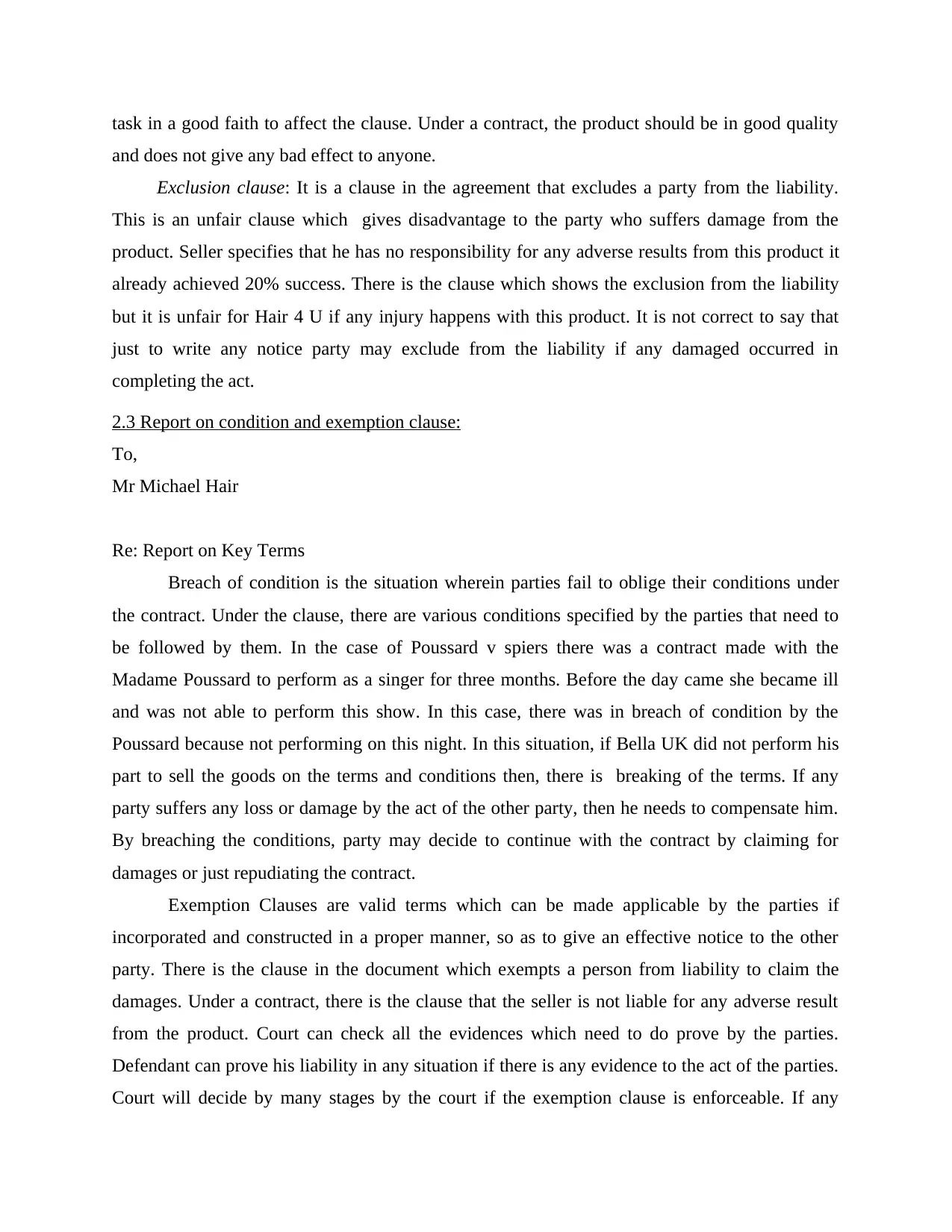
task in a good faith to affect the clause. Under a contract, the product should be in good quality
and does not give any bad effect to anyone.
Exclusion clause: It is a clause in the agreement that excludes a party from the liability.
This is an unfair clause which gives disadvantage to the party who suffers damage from the
product. Seller specifies that he has no responsibility for any adverse results from this product it
already achieved 20% success. There is the clause which shows the exclusion from the liability
but it is unfair for Hair 4 U if any injury happens with this product. It is not correct to say that
just to write any notice party may exclude from the liability if any damaged occurred in
completing the act.
2.3 Report on condition and exemption clause:
To,
Mr Michael Hair
Re: Report on Key Terms
Breach of condition is the situation wherein parties fail to oblige their conditions under
the contract. Under the clause, there are various conditions specified by the parties that need to
be followed by them. In the case of Poussard v spiers there was a contract made with the
Madame Poussard to perform as a singer for three months. Before the day came she became ill
and was not able to perform this show. In this case, there was in breach of condition by the
Poussard because not performing on this night. In this situation, if Bella UK did not perform his
part to sell the goods on the terms and conditions then, there is breaking of the terms. If any
party suffers any loss or damage by the act of the other party, then he needs to compensate him.
By breaching the conditions, party may decide to continue with the contract by claiming for
damages or just repudiating the contract.
Exemption Clauses are valid terms which can be made applicable by the parties if
incorporated and constructed in a proper manner, so as to give an effective notice to the other
party. There is the clause in the document which exempts a person from liability to claim the
damages. Under a contract, there is the clause that the seller is not liable for any adverse result
from the product. Court can check all the evidences which need to do prove by the parties.
Defendant can prove his liability in any situation if there is any evidence to the act of the parties.
Court will decide by many stages by the court if the exemption clause is enforceable. If any
and does not give any bad effect to anyone.
Exclusion clause: It is a clause in the agreement that excludes a party from the liability.
This is an unfair clause which gives disadvantage to the party who suffers damage from the
product. Seller specifies that he has no responsibility for any adverse results from this product it
already achieved 20% success. There is the clause which shows the exclusion from the liability
but it is unfair for Hair 4 U if any injury happens with this product. It is not correct to say that
just to write any notice party may exclude from the liability if any damaged occurred in
completing the act.
2.3 Report on condition and exemption clause:
To,
Mr Michael Hair
Re: Report on Key Terms
Breach of condition is the situation wherein parties fail to oblige their conditions under
the contract. Under the clause, there are various conditions specified by the parties that need to
be followed by them. In the case of Poussard v spiers there was a contract made with the
Madame Poussard to perform as a singer for three months. Before the day came she became ill
and was not able to perform this show. In this case, there was in breach of condition by the
Poussard because not performing on this night. In this situation, if Bella UK did not perform his
part to sell the goods on the terms and conditions then, there is breaking of the terms. If any
party suffers any loss or damage by the act of the other party, then he needs to compensate him.
By breaching the conditions, party may decide to continue with the contract by claiming for
damages or just repudiating the contract.
Exemption Clauses are valid terms which can be made applicable by the parties if
incorporated and constructed in a proper manner, so as to give an effective notice to the other
party. There is the clause in the document which exempts a person from liability to claim the
damages. Under a contract, there is the clause that the seller is not liable for any adverse result
from the product. Court can check all the evidences which need to do prove by the parties.
Defendant can prove his liability in any situation if there is any evidence to the act of the parties.
Court will decide by many stages by the court if the exemption clause is enforceable. If any
⊘ This is a preview!⊘
Do you want full access?
Subscribe today to unlock all pages.

Trusted by 1+ million students worldwide
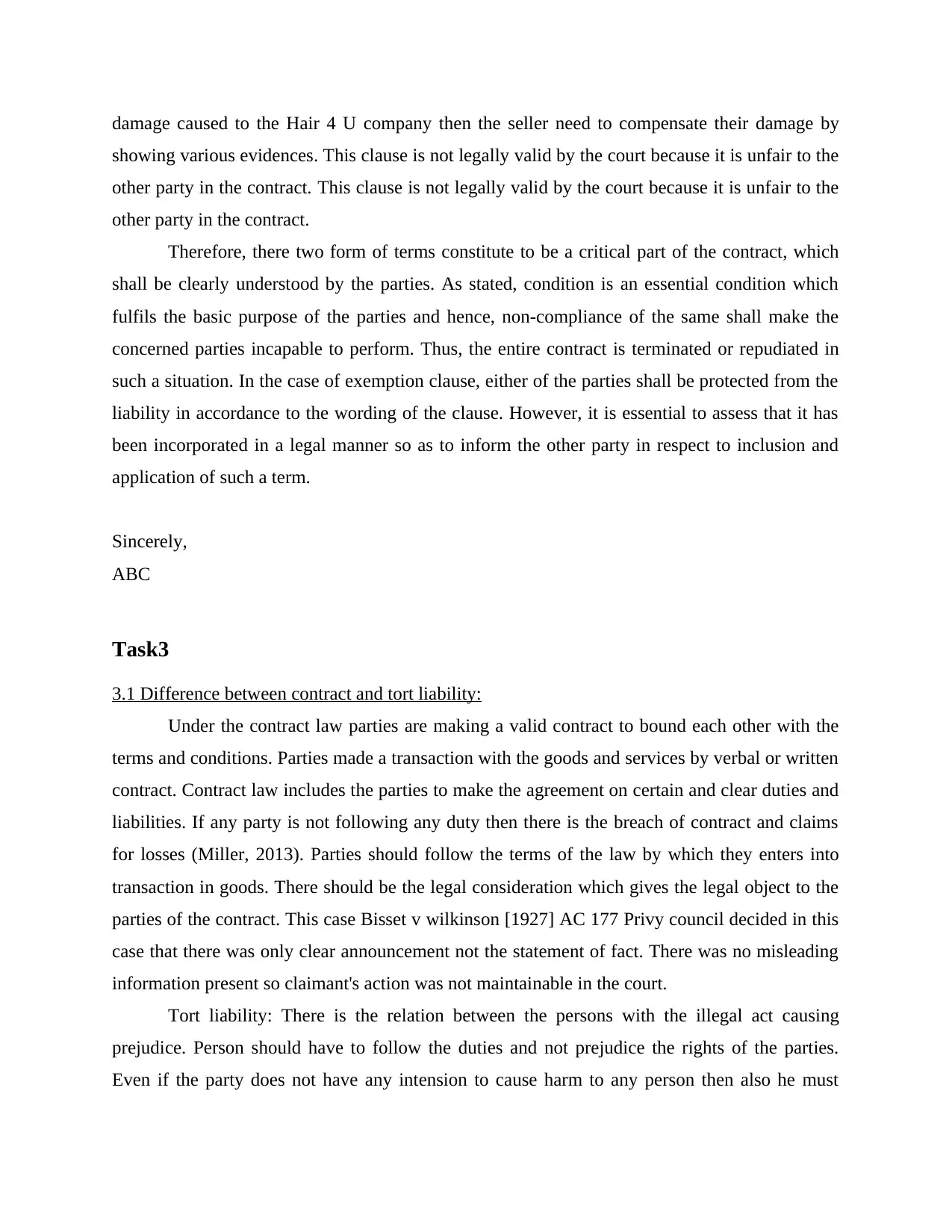
damage caused to the Hair 4 U company then the seller need to compensate their damage by
showing various evidences. This clause is not legally valid by the court because it is unfair to the
other party in the contract. This clause is not legally valid by the court because it is unfair to the
other party in the contract.
Therefore, there two form of terms constitute to be a critical part of the contract, which
shall be clearly understood by the parties. As stated, condition is an essential condition which
fulfils the basic purpose of the parties and hence, non-compliance of the same shall make the
concerned parties incapable to perform. Thus, the entire contract is terminated or repudiated in
such a situation. In the case of exemption clause, either of the parties shall be protected from the
liability in accordance to the wording of the clause. However, it is essential to assess that it has
been incorporated in a legal manner so as to inform the other party in respect to inclusion and
application of such a term.
Sincerely,
ABC
Task3
3.1 Difference between contract and tort liability:
Under the contract law parties are making a valid contract to bound each other with the
terms and conditions. Parties made a transaction with the goods and services by verbal or written
contract. Contract law includes the parties to make the agreement on certain and clear duties and
liabilities. If any party is not following any duty then there is the breach of contract and claims
for losses (Miller, 2013). Parties should follow the terms of the law by which they enters into
transaction in goods. There should be the legal consideration which gives the legal object to the
parties of the contract. This case Bisset v wilkinson [1927] AC 177 Privy council decided in this
case that there was only clear announcement not the statement of fact. There was no misleading
information present so claimant's action was not maintainable in the court.
Tort liability: There is the relation between the persons with the illegal act causing
prejudice. Person should have to follow the duties and not prejudice the rights of the parties.
Even if the party does not have any intension to cause harm to any person then also he must
showing various evidences. This clause is not legally valid by the court because it is unfair to the
other party in the contract. This clause is not legally valid by the court because it is unfair to the
other party in the contract.
Therefore, there two form of terms constitute to be a critical part of the contract, which
shall be clearly understood by the parties. As stated, condition is an essential condition which
fulfils the basic purpose of the parties and hence, non-compliance of the same shall make the
concerned parties incapable to perform. Thus, the entire contract is terminated or repudiated in
such a situation. In the case of exemption clause, either of the parties shall be protected from the
liability in accordance to the wording of the clause. However, it is essential to assess that it has
been incorporated in a legal manner so as to inform the other party in respect to inclusion and
application of such a term.
Sincerely,
ABC
Task3
3.1 Difference between contract and tort liability:
Under the contract law parties are making a valid contract to bound each other with the
terms and conditions. Parties made a transaction with the goods and services by verbal or written
contract. Contract law includes the parties to make the agreement on certain and clear duties and
liabilities. If any party is not following any duty then there is the breach of contract and claims
for losses (Miller, 2013). Parties should follow the terms of the law by which they enters into
transaction in goods. There should be the legal consideration which gives the legal object to the
parties of the contract. This case Bisset v wilkinson [1927] AC 177 Privy council decided in this
case that there was only clear announcement not the statement of fact. There was no misleading
information present so claimant's action was not maintainable in the court.
Tort liability: There is the relation between the persons with the illegal act causing
prejudice. Person should have to follow the duties and not prejudice the rights of the parties.
Even if the party does not have any intension to cause harm to any person then also he must
Paraphrase This Document
Need a fresh take? Get an instant paraphrase of this document with our AI Paraphraser
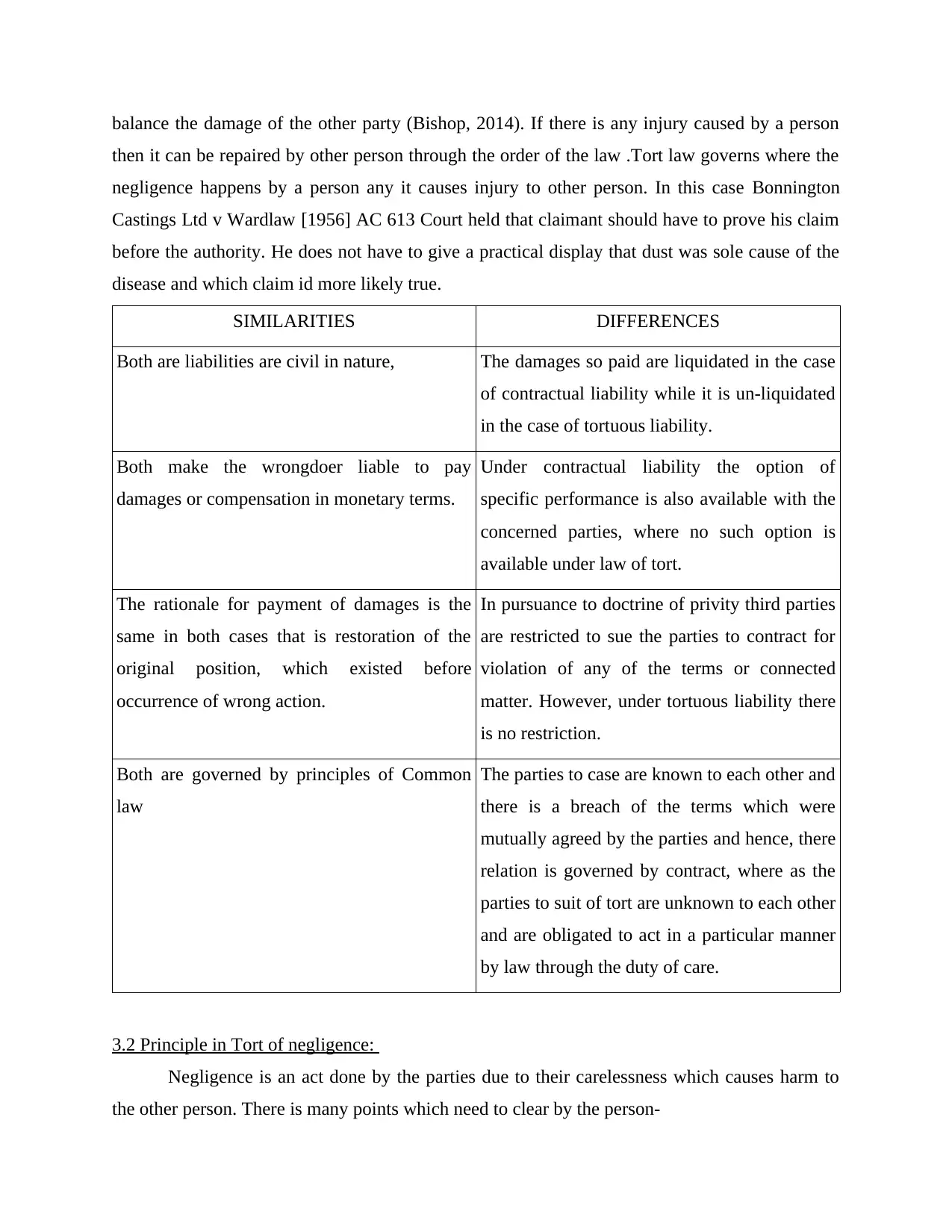
balance the damage of the other party (Bishop, 2014). If there is any injury caused by a person
then it can be repaired by other person through the order of the law .Tort law governs where the
negligence happens by a person any it causes injury to other person. In this case Bonnington
Castings Ltd v Wardlaw [1956] AC 613 Court held that claimant should have to prove his claim
before the authority. He does not have to give a practical display that dust was sole cause of the
disease and which claim id more likely true.
SIMILARITIES DIFFERENCES
Both are liabilities are civil in nature, The damages so paid are liquidated in the case
of contractual liability while it is un-liquidated
in the case of tortuous liability.
Both make the wrongdoer liable to pay
damages or compensation in monetary terms.
Under contractual liability the option of
specific performance is also available with the
concerned parties, where no such option is
available under law of tort.
The rationale for payment of damages is the
same in both cases that is restoration of the
original position, which existed before
occurrence of wrong action.
In pursuance to doctrine of privity third parties
are restricted to sue the parties to contract for
violation of any of the terms or connected
matter. However, under tortuous liability there
is no restriction.
Both are governed by principles of Common
law
The parties to case are known to each other and
there is a breach of the terms which were
mutually agreed by the parties and hence, there
relation is governed by contract, where as the
parties to suit of tort are unknown to each other
and are obligated to act in a particular manner
by law through the duty of care.
3.2 Principle in Tort of negligence:
Negligence is an act done by the parties due to their carelessness which causes harm to
the other person. There is many points which need to clear by the person-
then it can be repaired by other person through the order of the law .Tort law governs where the
negligence happens by a person any it causes injury to other person. In this case Bonnington
Castings Ltd v Wardlaw [1956] AC 613 Court held that claimant should have to prove his claim
before the authority. He does not have to give a practical display that dust was sole cause of the
disease and which claim id more likely true.
SIMILARITIES DIFFERENCES
Both are liabilities are civil in nature, The damages so paid are liquidated in the case
of contractual liability while it is un-liquidated
in the case of tortuous liability.
Both make the wrongdoer liable to pay
damages or compensation in monetary terms.
Under contractual liability the option of
specific performance is also available with the
concerned parties, where no such option is
available under law of tort.
The rationale for payment of damages is the
same in both cases that is restoration of the
original position, which existed before
occurrence of wrong action.
In pursuance to doctrine of privity third parties
are restricted to sue the parties to contract for
violation of any of the terms or connected
matter. However, under tortuous liability there
is no restriction.
Both are governed by principles of Common
law
The parties to case are known to each other and
there is a breach of the terms which were
mutually agreed by the parties and hence, there
relation is governed by contract, where as the
parties to suit of tort are unknown to each other
and are obligated to act in a particular manner
by law through the duty of care.
3.2 Principle in Tort of negligence:
Negligence is an act done by the parties due to their carelessness which causes harm to
the other person. There is many points which need to clear by the person-
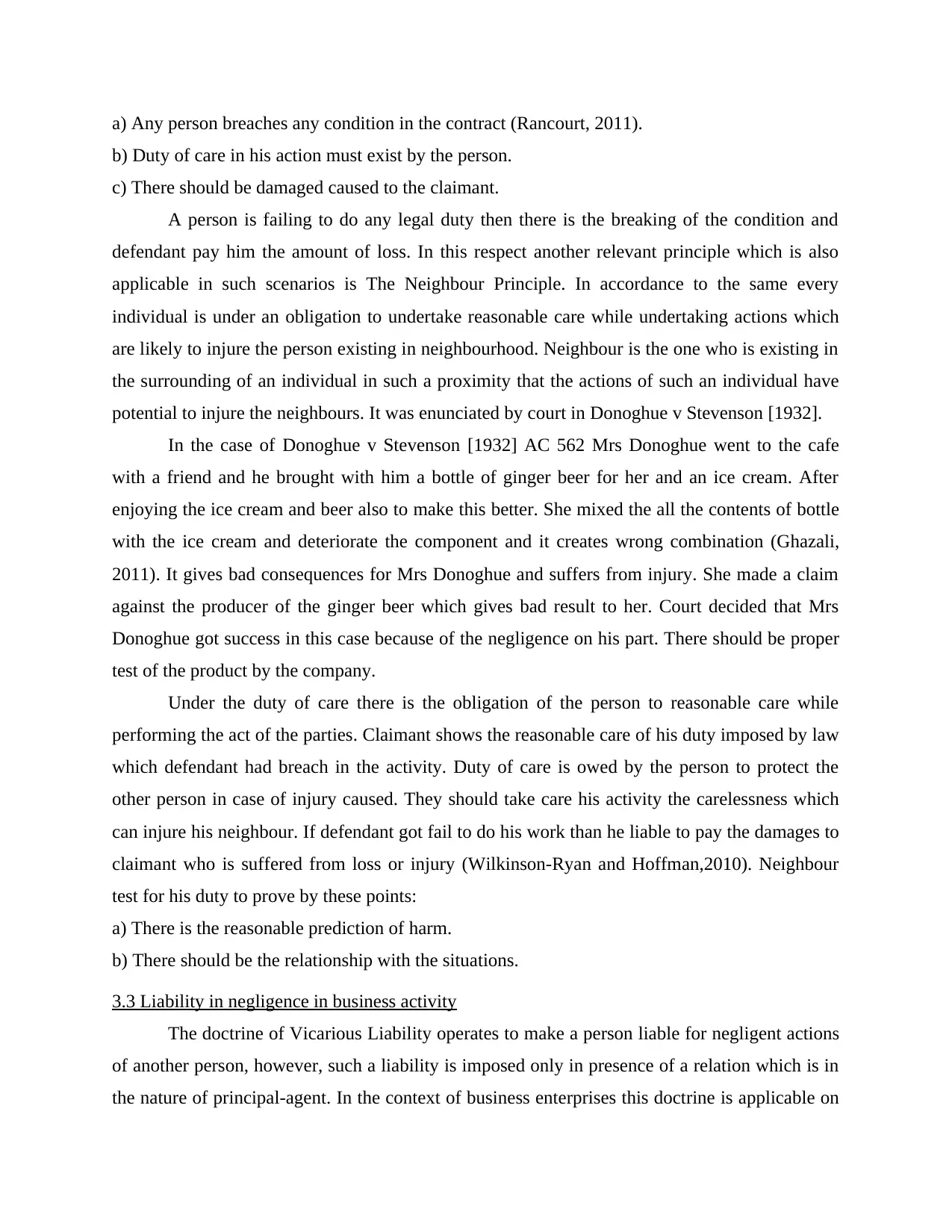
a) Any person breaches any condition in the contract (Rancourt, 2011).
b) Duty of care in his action must exist by the person.
c) There should be damaged caused to the claimant.
A person is failing to do any legal duty then there is the breaking of the condition and
defendant pay him the amount of loss. In this respect another relevant principle which is also
applicable in such scenarios is The Neighbour Principle. In accordance to the same every
individual is under an obligation to undertake reasonable care while undertaking actions which
are likely to injure the person existing in neighbourhood. Neighbour is the one who is existing in
the surrounding of an individual in such a proximity that the actions of such an individual have
potential to injure the neighbours. It was enunciated by court in Donoghue v Stevenson [1932].
In the case of Donoghue v Stevenson [1932] AC 562 Mrs Donoghue went to the cafe
with a friend and he brought with him a bottle of ginger beer for her and an ice cream. After
enjoying the ice cream and beer also to make this better. She mixed the all the contents of bottle
with the ice cream and deteriorate the component and it creates wrong combination (Ghazali,
2011). It gives bad consequences for Mrs Donoghue and suffers from injury. She made a claim
against the producer of the ginger beer which gives bad result to her. Court decided that Mrs
Donoghue got success in this case because of the negligence on his part. There should be proper
test of the product by the company.
Under the duty of care there is the obligation of the person to reasonable care while
performing the act of the parties. Claimant shows the reasonable care of his duty imposed by law
which defendant had breach in the activity. Duty of care is owed by the person to protect the
other person in case of injury caused. They should take care his activity the carelessness which
can injure his neighbour. If defendant got fail to do his work than he liable to pay the damages to
claimant who is suffered from loss or injury (Wilkinson-Ryan and Hoffman,2010). Neighbour
test for his duty to prove by these points:
a) There is the reasonable prediction of harm.
b) There should be the relationship with the situations.
3.3 Liability in negligence in business activity
The doctrine of Vicarious Liability operates to make a person liable for negligent actions
of another person, however, such a liability is imposed only in presence of a relation which is in
the nature of principal-agent. In the context of business enterprises this doctrine is applicable on
b) Duty of care in his action must exist by the person.
c) There should be damaged caused to the claimant.
A person is failing to do any legal duty then there is the breaking of the condition and
defendant pay him the amount of loss. In this respect another relevant principle which is also
applicable in such scenarios is The Neighbour Principle. In accordance to the same every
individual is under an obligation to undertake reasonable care while undertaking actions which
are likely to injure the person existing in neighbourhood. Neighbour is the one who is existing in
the surrounding of an individual in such a proximity that the actions of such an individual have
potential to injure the neighbours. It was enunciated by court in Donoghue v Stevenson [1932].
In the case of Donoghue v Stevenson [1932] AC 562 Mrs Donoghue went to the cafe
with a friend and he brought with him a bottle of ginger beer for her and an ice cream. After
enjoying the ice cream and beer also to make this better. She mixed the all the contents of bottle
with the ice cream and deteriorate the component and it creates wrong combination (Ghazali,
2011). It gives bad consequences for Mrs Donoghue and suffers from injury. She made a claim
against the producer of the ginger beer which gives bad result to her. Court decided that Mrs
Donoghue got success in this case because of the negligence on his part. There should be proper
test of the product by the company.
Under the duty of care there is the obligation of the person to reasonable care while
performing the act of the parties. Claimant shows the reasonable care of his duty imposed by law
which defendant had breach in the activity. Duty of care is owed by the person to protect the
other person in case of injury caused. They should take care his activity the carelessness which
can injure his neighbour. If defendant got fail to do his work than he liable to pay the damages to
claimant who is suffered from loss or injury (Wilkinson-Ryan and Hoffman,2010). Neighbour
test for his duty to prove by these points:
a) There is the reasonable prediction of harm.
b) There should be the relationship with the situations.
3.3 Liability in negligence in business activity
The doctrine of Vicarious Liability operates to make a person liable for negligent actions
of another person, however, such a liability is imposed only in presence of a relation which is in
the nature of principal-agent. In the context of business enterprises this doctrine is applicable on
⊘ This is a preview!⊘
Do you want full access?
Subscribe today to unlock all pages.

Trusted by 1+ million students worldwide
1 out of 18
Related Documents
Your All-in-One AI-Powered Toolkit for Academic Success.
+13062052269
info@desklib.com
Available 24*7 on WhatsApp / Email
![[object Object]](/_next/static/media/star-bottom.7253800d.svg)
Unlock your academic potential
Copyright © 2020–2025 A2Z Services. All Rights Reserved. Developed and managed by ZUCOL.





